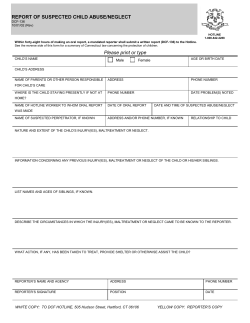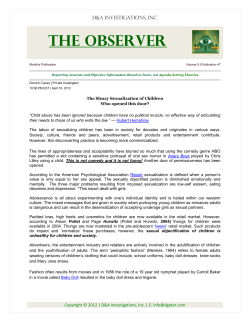
Duration of Maltreatment by Primary Form of Substantiated
Duration of Maltreatment by Primary Form of Substantiated Maltreatment in Ontario in 2013 Serena Goel, Kate Allan, Rachael Lefebvre & Barbara Fallon May 2015 Introduction The Ontario Incidence Study of Reported Child Abuse and Neglect, 2013 (OIS-2013) is the fifth provincial study to examine the incidence of reported child maltreatment and the characteristics of children and families investigated by child welfare authorities in Ontario. This Information Sheet examines the duration of substantiated maltreatment. Findings There were an estimated 125,281 maltreatment-related investigations conducted in Ontario in 2013. There were an estimated 97,951 investigations involving an incident of maltreatment and an estimated 27,330 risk-only investigations. At the conclusion of the initial investigation, 34% of maltreatment investigations were substantiated (an estimated 43,067 investigations). Workers were asked to describe the duration of the substantiated maltreatment by classifying investigations as single incident or multiple incident cases. Over half (59%) of all substantiated investigations were described by the investigating worker as involving multiple incidents of maltreatment. As shown in Table 1, the duration of maltreatment varies slightly by primary form of substantiated maltreatment. Over two thirds of substantiated sexual abuse investigations (68%) involved multiple incidents. Similarly, 62% of substantiated emotional maltreatment and 59% of substantiated neglect investigations involved multiple incidents. Just over half (58%) of substantiated physical abuse investigations and exposure to intimate partner violence (IPV) investigations (58%) involved multiple incidents of maltreatment. Please see Figure 1 for information on single and multiple incidents of substantiated maltreatment by primary form of maltreatment. Page 1 of 4 Information Sheet 158E Table 1. Duration of maltreatment by primary form of substantiated maltreatment in Ontario in 2013^ Primary Form of Maltreatment Physical Abuse Duration Sexual Abuse Emotional Maltreatment Neglect Exposure to IPV Total # % # % # % # % # % # % Single Incident 2,429 42 275 32 4,254 41 2,148 38 8,634 42 17,740 41 Multiple Incident 3,341 58 573 68 6,132 59 3,472 62 11,778 58 25,296 59 Total 5,770 100 848 100 10,386 100 5,620 100 20,412 100 43,036 100 ^ Based on a sample of 1,835 substantiated child maltreatment-related investigations with information about previous case openings. Percentages are column percentages. Figure 1. Duration of maltreatment by primary form of substantiated maltreatment in Ontario in 2013 80% 68% 70% 60% 59% 58% 62% 58% 50% 42% 41% 40% 42% 38% 32% Single incident MulKple incident 30% 20% 10% 0% Physical Abuse Sexual Abuse Neglect EmoKonal Exposure to Maltreatment IPV Background Due to changes in investigation mandates and practices over the last 15 years, the OIS-2008 and OIS-2013 differed from previous cycles in that they tracked both risk-only investigations and maltreatment investigations. Risk-only investigations were those in which a specific past incident of maltreatment was not suspected or alleged to have occurred, but rather a constellation of Page 2 of 4 Information Sheet 158E factors lead to concerns that a child may be maltreated in the future (e.g., caregiver with a substance abuse issue). Methodology The OIS-2013 used a multi-stage sampling design to select a representative sample of 17 child welfare agencies in Ontario and then to select a sample of cases within these agencies. Information was collected directly from child protection workers on a representative sample of 5,265 child protection investigations conducted during a three-month sampling period in 2013. This sample was weighted to reflect provincial annual estimates. After two weighting procedures were applied to the data, the estimated number of maltreatment-related investigations (i.e., maltreatment and risk-only investigations) conducted in Ontario in 2013 was 125,281. For maltreatment investigations, information was collected regarding the primary form of maltreatment investigated as well as the level of substantiation for that maltreatment (substantiated, suspected, or unfounded). Thirty-two forms of maltreatment were listed on the data collection instrument, and these were collapsed into five broad categories: physical abuse (e.g., hit with hand), sexual abuse (e.g., exploitation), neglect (e.g., educational neglect), emotional maltreatment (e.g., verbal abuse or belittling), and exposure to intimate partner violence (IPV) (e.g., direct witness to physical violence). Workers listed the primary concern for the investigation, and could also list secondary and tertiary concerns. For each risk investigation, workers determined whether the child was at risk of future maltreatment. The worker could decide that the child was at risk of future maltreatment (confirmed risk), that the child was not at risk of future maltreatment (unfounded risk), or that the future risk of maltreatment was unknown. Workers were asked to provide information on various other aspects of their investigation, including the characteristics of the household, caregivers, and child subject of the investigation, the history of previous child welfare case openings, and the short-term child welfare service dispositions. Limitations The OIS collects information directly from child welfare workers at the point when they completed their initial investigation of a report of possible child abuse or neglect, or risk of future maltreatment. Therefore, the scope of the study is limited to the type of information available to them at that point. The OIS does not include information about unreported maltreatment nor about cases that were investigated only by the police. Also, reports that were made to child welfare authorities but were screened out (not opened for investigation) were not included. Similarly, reports on cases currently open at the time of case selection were not included. The study did not track longer-term service events that occurred beyond the initial investigation. Three limitations to estimation method used to derive annual estimates should also be noted. The agency size correction uses child population as a proxy for agency size; this does not account for Page 3 of 4 Information Sheet 158E variations in per capita investigation rates across agencies in the same strata. The annualization weight corrects for seasonal fluctuation in the volume of investigations, but it does not correct for seasonal variations in types of investigations conducted. Finally, the annualization weight includes cases that were investigated more than once in the year as a result of the case being reopened following a first investigation completed earlier in the same year. Accordingly, the weighted annual estimates represent the child maltreatment-related investigations, rather than investigated children. Comparisons across OIS reports must be made with caution. The forms of maltreatment tracked by each cycle were modified to take into account changes in investigation mandates and practices. Comparisons across cycles must in particular take into consideration the fact that the OIS-2008 was the first to explicitly track risk-only investigations. Suggested citation: Goel, S., Allan, K., Lefebvre, R. & Fallon, B. (2015). Duration of Maltreatment by Primary Form of Substantiated Maltreatment in Ontario 2013. CWRP Information Sheet #158E. Toronto, ON: Faculty of Social Work, University of Toronto. Page 4 of 4 Information Sheet 158E
© Copyright 2025












